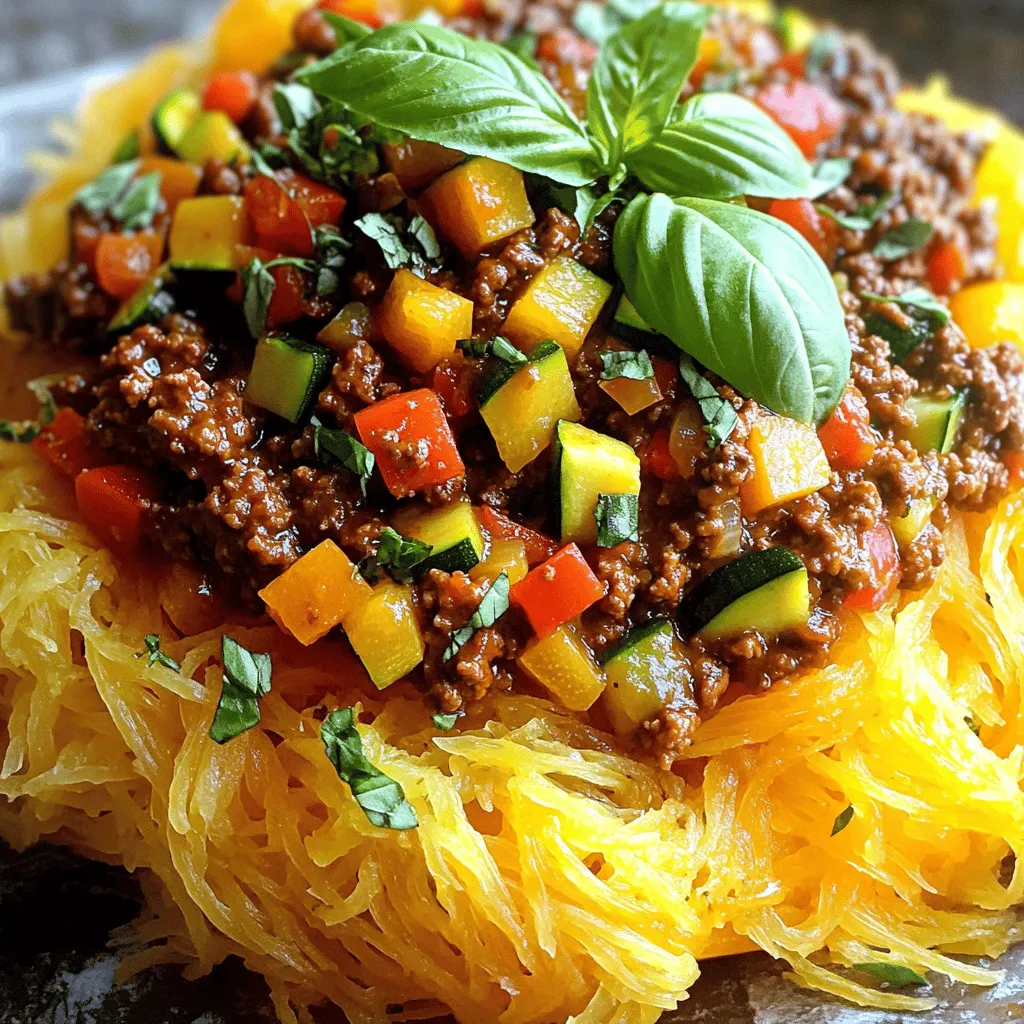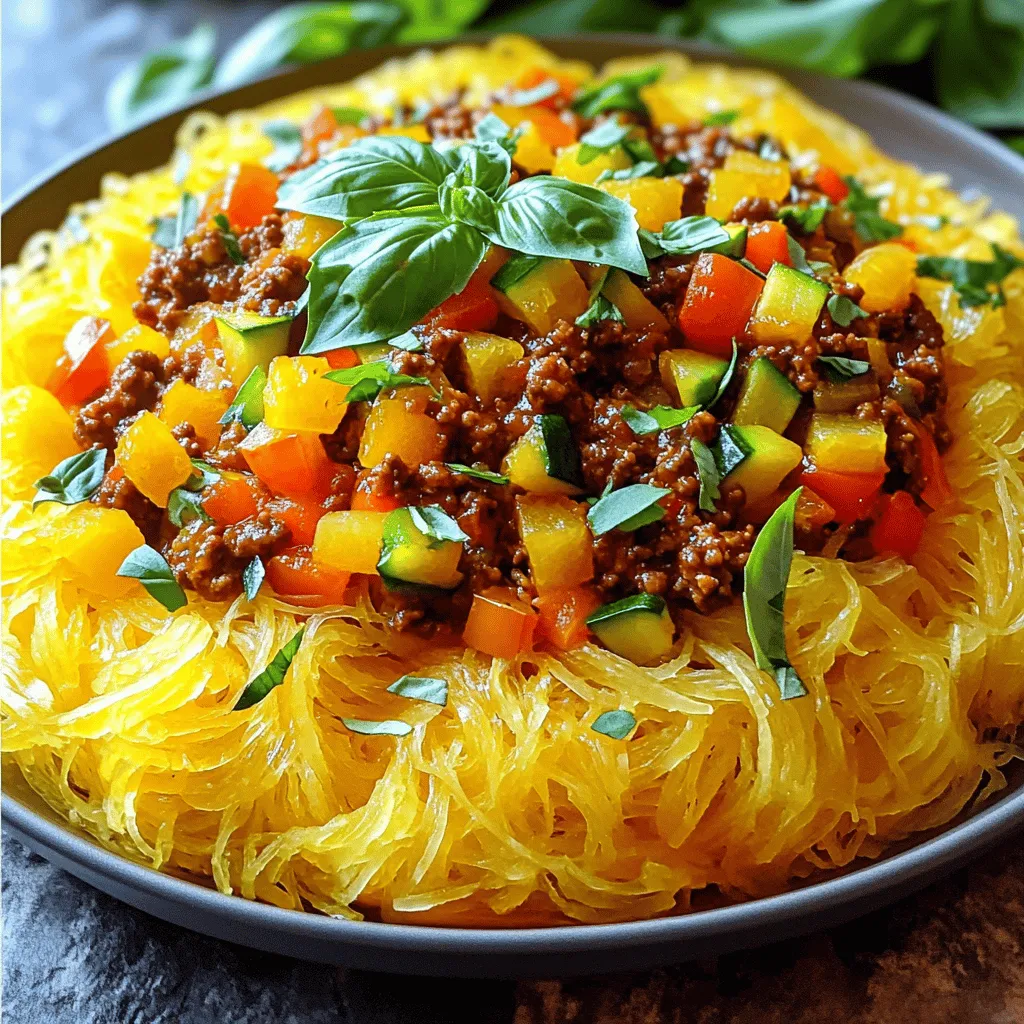If you’re looking for a healthy twist on a classic dish, you’ll love this Spaghetti Squash Bolognese recipe! It’s simple to make and packed with flavor. You’ll enjoy every bite of the tender squash covered in rich, meaty sauce. In this post, I’ll guide you through the ingredients, steps, and tips for a perfect meal. Let’s dive in and transform your dinner with this tasty and easy recipe!

Ingredients
Complete Ingredient List
To make Spaghetti Squash Bolognese, gather these items:
– 1 medium spaghetti squash
– 1 tablespoon olive oil
– 1 onion, finely chopped
– 2 cloves garlic, minced
– 1 carrot, diced
– 1 celery stalk, diced
– 1 bell pepper (any color), diced
– 1 zucchini, diced
– 1 (14 oz) can crushed tomatoes
– 1 tablespoon tomato paste
– 1 teaspoon dried oregano
– 1 teaspoon dried basil
– Salt and pepper to taste
– Fresh basil leaves for garnish
Suggested Fresh Ingredients
For a fresh twist, consider using:
– Fresh basil instead of dried
– A mix of colorful bell peppers
– Seasonal veggies like spinach or mushrooms
These fresh ingredients boost flavor and nutrition. They add color and texture too.
Pantry Staples for Bolognese
You might already have these in your kitchen:
– Olive oil
– Garlic
– Canned crushed tomatoes
– Tomato paste
– Dried herbs like oregano and basil
– Salt and pepper
These pantry staples make the sauce rich. They create that classic Bolognese taste.
Step-by-Step Instructions
Preparing the Spaghetti Squash
First, preheat your oven to 400°F (200°C). Cut the spaghetti squash in half lengthwise. Be careful while cutting! Scoop out the seeds with a spoon. Drizzle a bit of olive oil inside each half. Then, sprinkle with salt and pepper. Place the squash cut side down on a baking sheet. Bake it for 30-40 minutes. You want it soft enough to scrape with a fork.
Cooking the Bolognese Sauce
While the squash bakes, heat olive oil in a large skillet over medium heat. Add the chopped onion and sauté until it looks clear, about 3-4 minutes. Next, stir in the minced garlic, diced carrot, celery, and bell pepper. Cook for another 5 minutes. This makes the veggies tender. Then, add the diced zucchini and cook until it gets soft. Pour in the crushed tomatoes and add the tomato paste, oregano, basil, salt, and pepper. Mix well. Lower the heat and let it simmer for 15-20 minutes. Stir it occasionally to blend the flavors.
Combining the Two
Once the spaghetti squash is done, take it out from the oven. Let it cool for a few minutes. Use a fork to scrape the flesh into spaghetti-like strands. Place these strands on a plate. Top with your Bolognese sauce, and don’t forget to garnish with fresh basil leaves. Enjoy your healthy and delicious meal!
Tips & Tricks
Perfecting the Bolognese Flavor
To get a rich Bolognese flavor, start with good olive oil. Sauté the onion until it turns clear. This step builds a tasty base. Add garlic next for a nice aroma. Using fresh herbs like basil and oregano makes a big difference. If you want a bit more depth, add a splash of red wine while the sauce simmers. Let it cook slowly for about 20 minutes. This time lets the flavors mix well.
Cooking Squash to Perfection
Cooking spaghetti squash is simple but needs care. Start by cutting the squash in half. Scoop out the seeds before seasoning. Drizzle olive oil inside and sprinkle salt and pepper. Make sure to place it cut side down on a baking sheet. Bake it at 400°F for 30 to 40 minutes. You know it’s ready when you can scrape the flesh easily with a fork.
Serving Suggestions
When serving, use a fork to create the noodle strands. Place the strands on a plate and top with the Bolognese sauce. A few fresh basil leaves on top add color and taste. If you like cheese, sprinkle some grated Parmesan for extra flavor. This dish pairs well with a simple green salad or crusty bread. Enjoy your healthy meal!

Variations
Vegetarian and Vegan Options
You can easily make this dish vegetarian or vegan. Simply skip the meat and use extra veggies. For a vegan twist, swap in vegetable broth for added taste. You can also add lentils or chickpeas for protein. These swaps keep the dish hearty and flavorful.
Protein Additions
If you want more protein in your meal, add ground turkey or beef. You can also use plant-based proteins like tempeh or lentils. Just brown them in the skillet before adding the vegetables. This way, you keep the rich flavor of Bolognese while boosting nutrition.
Spice and Herb Variations
Feel free to adjust the spices to suit your taste. A pinch of red pepper flakes adds heat. Fresh herbs like thyme or rosemary can deepen the flavors. You can also try adding a splash of red wine for a richer sauce. Experimenting with spices makes each meal unique and exciting.
Storage Info
Storing Leftovers
After you enjoy your Spaghetti Squash Bolognese, store any leftovers in an airtight container. This keeps the dish fresh and tasty. You can keep it in the fridge for up to three days. Make sure to let the dish cool down before sealing it. This step helps prevent moisture build-up inside the container.
Reheating Instructions
To reheat, you can use a microwave or a stovetop. If using a microwave, place the portion on a plate and cover it with a damp paper towel. Heat for about 1-2 minutes, checking if it’s warm throughout. For stovetop reheating, warm the Bolognese sauce in a pan over low heat until it’s hot. Stir occasionally to avoid burning.
Freezing Tips
If you want to save your Spaghetti Squash Bolognese for later, freezing is a great option. First, let the dish cool completely. Then, pack it in a freezer-safe container. You can also use freezer bags for easy storage. Squeeze out as much air as possible before sealing. This can keep the dish good for about three months. When you’re ready to eat, thaw it overnight in the fridge before reheating.
FAQs
Can I use other squash varieties?
Yes, you can! Other squash types like butternut or acorn squash work well. They have a sweet taste that adds flavor. Keep in mind, they may not have the same noodle-like texture. You might need to adjust cooking times based on the squash type. Experimenting can lead to fun new dishes.
How do I know when the spaghetti squash is done?
You will know it’s done when the flesh is soft. After baking for 30-40 minutes, poke it with a fork. If it easily scrapes into strands, it is ready. If it feels firm or hard, bake it a little longer. Trust your fork; it is the best test!
What are the nutritional benefits of spaghetti squash?
Spaghetti squash is low in calories but high in nutrients. It is rich in vitamins A and C, which help your body. It also has fiber, which is good for digestion. Plus, it is a great low-carb alternative to regular pasta. Eating it can help you feel full and satisfied.
We explored how to make a great Bolognese sauce with spaghetti squash. We covered ingredients, step-by-step cooking, and helpful tips. You also learned about tasty variations and storage methods.
Remember, cooking is about finding what you enjoy. Try different spices and flavors to make this dish your own. Don’t be afraid to mix things up and have fun. Happy cooking!

